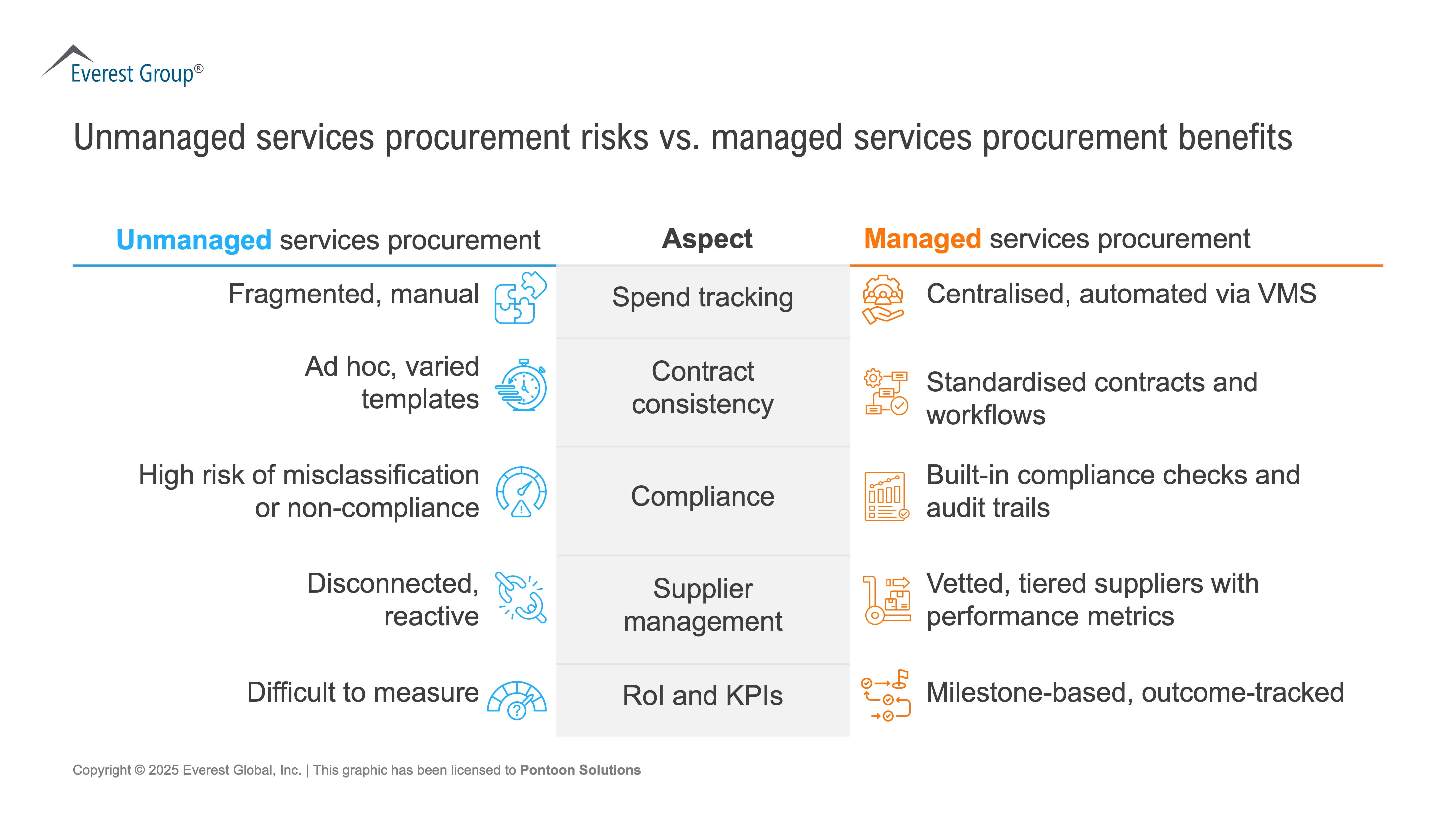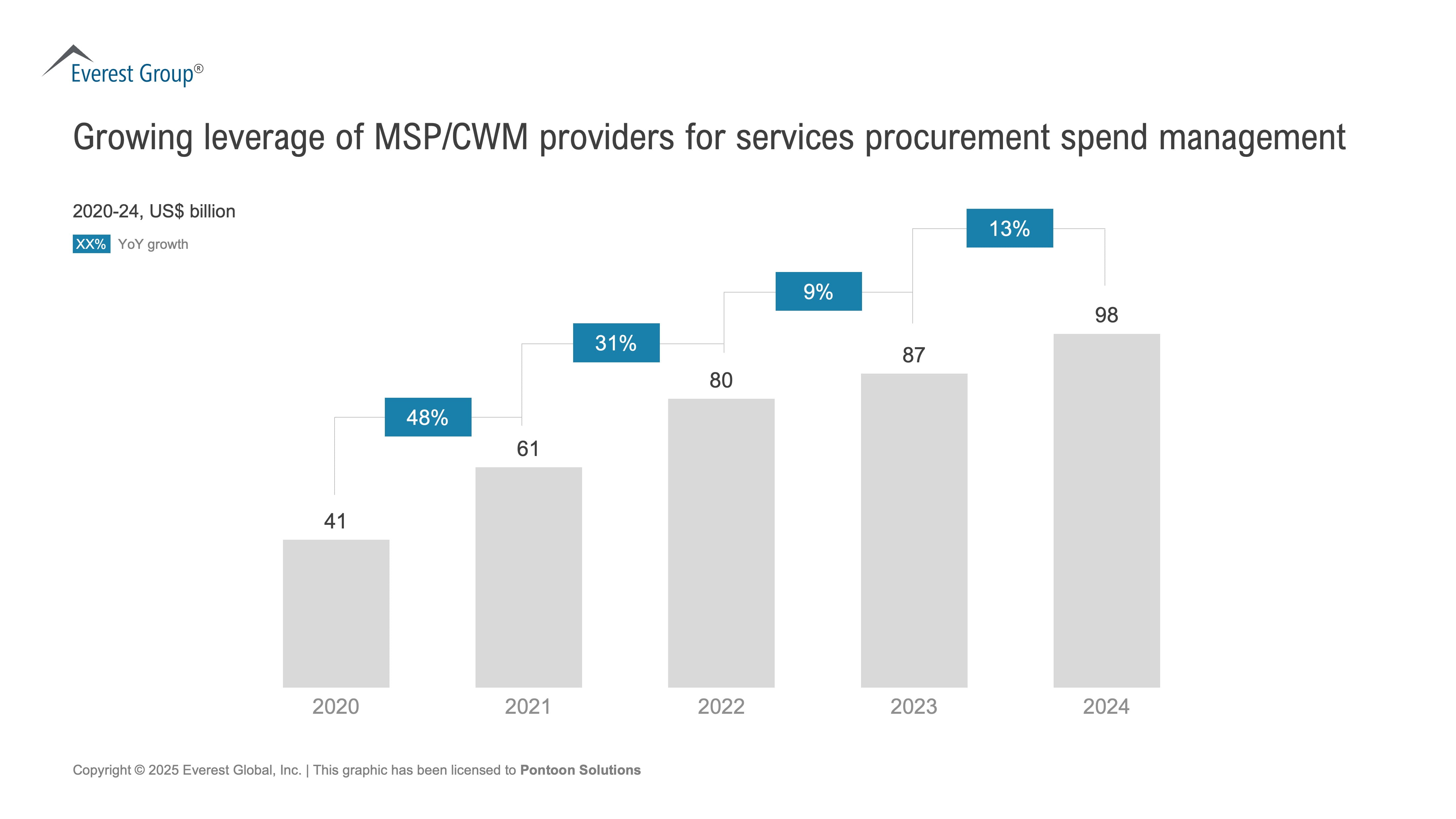In this article, Everest Group’s guest authors—Soumya Bansal and Lokesh Goyal—explore how organisations are evolving their contingent workforce strategies to bring structure, visibility, and control to services procurement management.
As workforce strategies shift toward greater flexibility, the services procurement management for Statement of Work (SOW) engagements is becoming a vital part of how organisations access specialised skills and deliver business outcomes. Traditionally treated as a procurement function managed in silos, services procurement engagements are now being viewed through a talent lens — requiring more structure, visibility, and control. To truly unlock the value of services procurement, organisations must move beyond ad hoc approaches and embrace a formal, technology-enabled framework.
Managed Service Providers (MSPs) are playing a key role in this transformation, bringing expertise, tools, and governance to help businesses streamline services procurement management and drive better results. This blog explores the growing need for formalising services procurement management and how MSPs can support organisations on this journey.
From chaos to control: Expanding contingent workforce programmes to enable effective Services Procurement management
As the workforce landscape undergoes a fundamental shift, organisations are increasingly embracing flexible talent models that span across temporary workers, independent contractors/freelancers, and outsourced services.
Among these, the services procurement channel is gaining high importance. While organisations spend significant amounts and rely heavily on services provided by consulting firms, IT providers, accounting firms, law firms, marketing agencies, call-center operators, and facilities management companies, they have traditionally considered these engagements as contracts routed through procurement functions, all with management and tracking responsibilities sitting with individual business units and project teams.
However, things have changed with services procurement management starting to be considered from a resourcing perspective.
Acquiring talent through well-defined statement of work enables organisations to hold suppliers accountable for the outcomes and reduce risks to business operations. Therefore, services procurement engagements are now emerging as a critical pillar of the overall workforce strategy. Many staffing suppliers in the market traditionally sourcing only temporary workers in staff augmentation channels are also now pivoting to offer outcome based managed services to its clients.
A deliberate, technology-driven, and performance-oriented approach to manage services procurement talent is the need of the hour. However, despite its growing importance, many organisations continue to manage services procurement engagements in an ad hoc, decentralised manner, where the spend still sits within individual business units or project teams, often managed in silos, exposing themselves to cost leakage, compliance risk, and missed opportunities.
The growing need to formalise services procurement spend
To mitigate the risks associated with ad-hoc services procurement management and unlock greater operational and financial value, organisations must move toward a more structured and strategic approach to services procurement management. Some of the major benefits from a formal services procurement management include:
- Improved spend visibility: Centralised systems provide a clear view of where and how services dollars are being spent, enabling better budgeting, forecasting, and strategic decision-making.
- Contract standardisation: Use of consistent templates and defined contract language ensures clarity in scope, responsibilities, and accountability across all engagements.
- Reduced compliance risk: Structured processes help mitigate misclassification errors and enforce proper payment terms.
- Better project control: Milestone tracking, defined Key Performance Indicators (KPIs), and change order workflows help ensure projects stay on schedule and within budget, reducing delays and overruns.
- Tail spend management: Consolidating suppliers and formalising vendor selection reduces one-off contracts and leakage, leading to more efficient and cost-effective sourcing.
Three key pillars to unlock the full value of services procurement management
To realise the benefits associated with formal services procurement management at scale, organisations need to build a structured services procurement management framework. At the core of this transformation are three foundational pillars—technology enablement, centralised processes, and robust governance—that collectively empower organisations to streamline services procurement lifecycle management, mitigate risks, and drive better business outcomes.
- Technology enablement: Leveraging digital tools such as Vendor Management Systems (VMS) and SOW authoring platforms helps automate workflows and track performance.
- Centralised processes: Standardising how SOWs are created, approved, and managed across the organisation for consistency and driving cross-functional alignment.
- Robust governance; Establishing clear policies, compliance checks, and audit mechanisms to reduce operational and regulatory risk and ensure accountability.
Exhibit 1: Unmanaged services procurement risks vs. managed services procurement benefits

Contingent Workforce Management (CWM) / Managed Service Providers (MSPs) as enablers for Services Procurement transformation
As organisations seek a more structured, technology-enabled approach to manage their growing services procurement spend, MSP/CWM providers are emerging as key enablers.
Traditionally focused on transactional labour procurement, MSPs are now evolving into the role of strategic partners for contingent talent—bringing the expertise, technology, and governance frameworks needed to streamline services procurement management.
The SOW spend managed through CWM/MSP providers is witnessing growth as enterprises realise the importance of formalising their services procurement programmes.
Exhibit 2: Growing leverage of MSP/CWM providers for services procurement spend management
As a starting point, organisations can engage MSPs to tackle unmanaged tail spend, i.e. fragmented, low-visibility, less strategic vendor engagements that drain budgets without accountability. MSPs have also build capabilities in managing strategic services procurement programmes: addressing high-value projects, optimising supplier selection, and aligning outcomes to business objectives. Organisations can think about engaging MSPs for such strategic engagements as a further evolution of their services procurement management programmes. By effectively leveraging MSPs to manage services procurement spend, organisations can realise the following advantages: Overall, services procurement is no longer just a procurement activity—it’s a strategic lever. Organisations that fail to formalise services procurement management, risk falling behind in a world where agility, transparency, and accountability are non-negotiable. Contrary, those that embrace a structured services procurement management strategy—powered by technology and MSP/CWM partnerships—gain tighter cost control, stronger supplier performance, reduced risk exposure, and clearer alignment with business goals.

The time to formalise and streamline is now.
